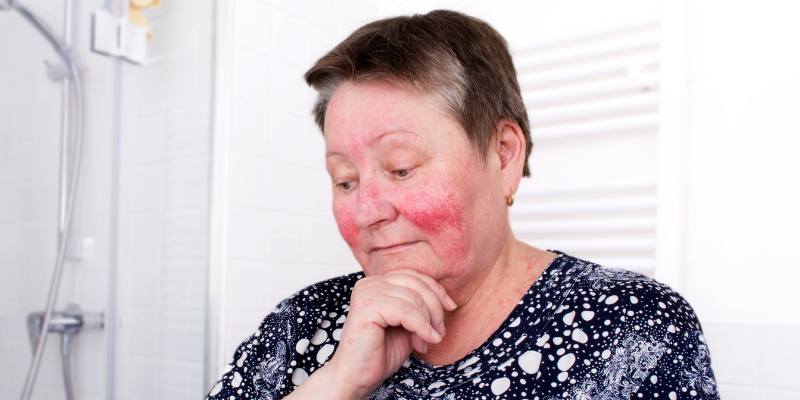What Are the Different Types of Rosacea?

Up to 16 million Americans have a skin condition known as rosacea, which is typically characterized by consistent red facial flushing. Although we are still unsure of the exact causes of rosacea, we do know that there is likely a genetic component, it is associated with chronic inflammation, and there are four main subtypes of this condition.
If you think you might have one of these four types of rosacea or are wondering, “What kind of rosacea do I have?” talk to a board-certified dermatologist as soon as you can, since rosacea needs to be treated early for the best outcome.
1. Flushing and Broken Blood Vessels
If your face frequently flushes red for more than about ten minutes after exercise, drinking alcohol, being outdoors in warm weather, or other common triggers, you may have what’s called erythematotelangiectatic rosacea (ETR). This type of rosacea is characterized by facial flushing and broken blood vessels, which are likely caused by years of dilating and constricting.
Prescription Rhofade™ (1% oxymetazoline hydrochloride) is a new FDA-approved topical treatment option that helps to calm erythema (redness) without the use of antibiotics by constricting blood vessels. You only need to apply it once in the morning for 12-hour relief from redness. This breakthrough treatment is the first of its kind to directly address redness, rather than the pimple-like bumps caused by the second subtype of rosacea.
2. Papulopustular or Acne-Like Rosacea
Flushing and redness can also be present with papulopustular rosacea, but papules or acne-like bumps will also appear on top of redness. Some evidence suggests that this subtype could be associated with allergy-like responses within your body’s immune system. Other studies have shown an association with the microbiota (bacteria) in the gut. Additional research is still needed to uncover the exact cause of rosacea.
Because the symptoms of papulopustular rosacea often closely resemble acne, it is important to find at top dermatologist in your area who can accurately assess and diagnose your skin. If you are diagnosed with rosacea, beginning treatment immediately can help to not only reduce your symptoms but may also prevent them from becoming more severe over time.
Some of the most common treatment options for this type of rosacea include Metrogel® (1% metronidazole), a topical antibiotic, and Oracea® (doxycycline), an oral antibiotic. Both of these treatments specifically target bumps and pimples associated with this kind of rosacea.
3. Phymatous Rosacea
Rosacea subtype 3 is characterized by thick, red skin that usually develops on the nose, but can also affect your chin, ears, forehead, and eyelids. Although rosacea in general is more common in fair-skinned women than in men, phymatous rosacea is most commonly seen in men.
Sun protection, trigger avoidance, and a proper diagnosis and treatment from your dermatologist are the best ways to manage phymatous rosacea. As with other subtypes, catching it early on is crucial for minimizing symptoms.
4. Ocular Rosacea
Many people who struggle with red, burning, stinging, or uncomfortable eyes do not realize that they could have ocular rosacea. In many cases, this type of rosacea occurs in conjunction with subtype 1 — facial redness, flushing, and broken blood vessels. Sometimes, ocular rosacea develops before symptoms appear on your skin.
Practicing good eye hygiene and working with your doctor to diagnose and treat the underlying cause can control your symptoms. However, there is currently no cure for rosacea.
What If I Think I Have Rosacea?
If you think you have any of these common symptoms of rosacea, see a doctor right away so you can get an accurate diagnosis. If you do have rosacea, early treatment can treat your symptoms and may help to prevent more severe symptoms from developing down the road. There are also new treatment options available, such as once-daily Rhofade™, that can help you manage your condition without the use of antibiotics.
It is also important to avoid triggers that could cause your symptoms to flare up, including spicy foods, warm drinks like coffee and hot chocolate, sun exposure, and intense exercise.
In Summary
Although there is not currently a cure for rosacea, early detection and treatment can effectively manage this common condition. For this reason, it is important to see a doctor as soon as you notice symptoms of any of the four subtypes of rosacea.
©2018 MetaBeauty, Inc.


